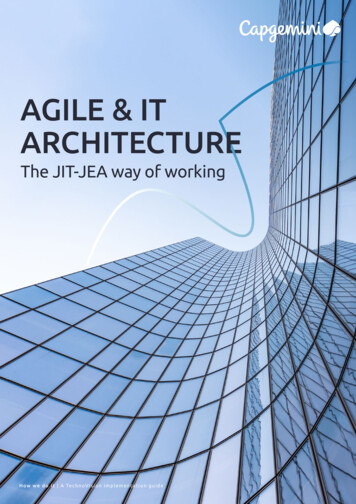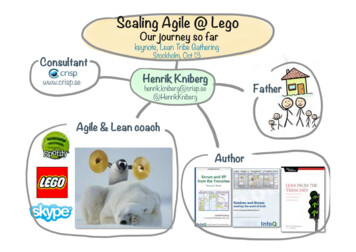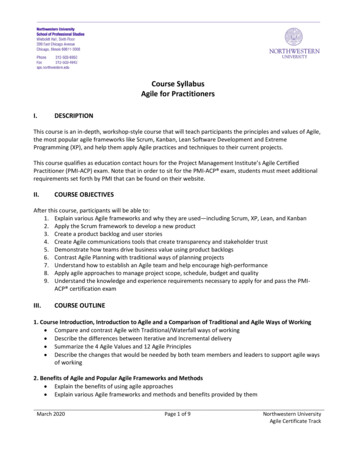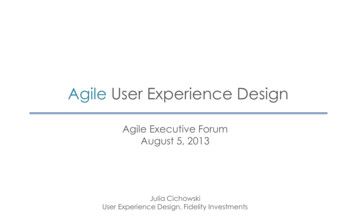
Transcription
AGILE & ITARCHITECTUREThe JIT-JEA way of working1H o Awgwile d& oI Ti tA r Ac hTei t ecchtnuor Ve ision implementation guide
WELCOME TO THE JIT-JEA WAY OF WORKINGAgility is a central requirement for many organizations. For organizations lookingfor a digital future, the question is no longer whether an agile innovation shouldbe used, but which innovation, when, and how. Questions we should ask ourselvesinclude: How to incorporate agility into the 2022 digital development plan andoperating landscape? What steps would accelerate digital transformation?How best to architect in an agile way?At its core, the term “agile” refers to an iterative, incremental method of managing design and buildingactivities with an aim of developing new products in a highly flexible and interactive manner. As notedin the 2019 Capgemini “Agile at Scale” report, companies are starting to adopt and scale agile ways ofworking, changing the way they work.And this change is also impacting the way we, as (IT) architects work. We are living in a complex andfast-moving world, ever gathering pace. What was acceptable yesterday, will not be accepted tomorrow.Our world is shifting, client expectations are changing and so is the market. Now more than ever, ourclients expect their IT function to seamlessly support the business as we see the lines of business andtechnology blurring beyond recognition. As a result, we need to change and adopt new ways of working.We need to respond to change, at an ever increasing frequency.There is a common misconception in the IT industry that architecture must be created“top-down;” where architecture-related artifacts are developed over two or three months - in onego - proving that “architecture” and “agile” are not compatible. This is not true. Working as a team,following a more agile architecture approach and designing a solution can be done, in one day.Of course, the level of detail will not be as deep as with a solution that takes months to produce,but it may be sufficient to take any necessary decisions to move forward.Working in an agile way can drive change creating business opportunities through technologicalinnovation. Architects can shape and translate business and IT strategy into realizable and sustainabletechnology solutions, while moving end-to-end solution delivery ownership from idea to benefitsdelivery. How to do this successfully in an agile fashion is the subject for debate in this paper.Working with a dedicated team of IT Architects from across the Capgemini Group, we hope to provide adetailed and comprehensive overview on not only what we in Capgemini mean by “agile IT architecture,”but also to outline how we architect in an agile way. Our thanks goes out to everyone who has beeninvolved in creating this paper, our experts leading the agile charge in architecture.GUNNAR MENZEL,K AI SCHROEDER,S T E FA N O R O S S I N I ,Master Certified ArchitectGlobal Architects Community LeadItaly Industrialization LeadManchester, UKMünchen, DEMilan, IT2 Agile & IT Architecture
CONTENTS1 INTRODUCTION41.1WHAT IS IT ARCHITECTURE?51.2WHAT IS AGILE?51.3WHAT IS AGILE ARCHITECTURE AND WHY JIT-JEA?52 ARCHITECTURE IN AGILE73 AGILE IN ARCHITECTURE104 THE JIT-JEA CONCEPT134.1JUST ENOUGH ARCHITECTURE144.1.1 EMERGING AND INTENTIONAL ARCHITECTURE144.1.2 ARCHITECTURAL RUNWAY154.1.3 MINIMUM VIABLE ARCHITECTURE164.1.4 DATA DRIVEN ARCHITECTURE164.2JUST ENOUGH DOCUMENTATION4.2.1 DOCUMENTATION AS CODE4.3JUST ENOUGH GOVERNANCE1617174.3.1 FASTER ARCHITECTURAL DECISION-MAKING184.3.2 VALIDATING SOLUTIONS AGAINST ARCHITECTURAL COMPLIANCE184.3.3 STRUCTURAL COLLABORATION BETWEEN ARCHITECTS AND DELIVERY TEAMS194.3.4 ARCHITECTURE COMMUNITY OF PRACTICE194.3.5 ARCHITECTURE DECISION RECORD (ADR)194.4JUST IN TIME204.5IN ITERATION SIZE CHUNKS214.6CONCLUDING REMARKS ON JIT-JEA225 BIBLIOGRAPHY236 AUTHORS243 Agile & IT Architecture
INTRODUCTIONToday, we as architects are often faced withthe challenge of developing just enough. Agiledevelopment demands faster turnaround, expectingquick iterations and delivering just about the rightamount of documentation; not too much and nottoo little. But what is actually good enough?When have we as architects developed enoughmaterial? What do we mean by “just enough?”JIT-JEAIN ITERATIONSIZE CHUNCKSJUST IN TIMEJUST ENOUGHGOVERNANCEJUST ENOUGH ARCHITECTUREJUST ENOUGHDOCUMENTATIONThis section provides the context and keydefinitions to frame the next chapters ofthis document. We do not intend to redefineconcepts, but merely ensure that the scopeof this agile IT architecture point of view isclear. Throughout this paper we will use theterms “architecture” and “architect.” To avoidconfusion with other professions, wheneverwe use the term, we are referring to Businessand IT (Information Technology) architectureand Business and IT architects.Developing “just enough architecture” isa common challenge. It is all too easy for thestatement to become an end-goal in itself, ratherthan something that is there to help the businessand development process. As a result, it canbecome difficult to determine when exactlyto stop designing the architecture.To assist architects who are working in an agilecontext, Capgemini encourages architects to connectwith Agile and DevOps communities all aroundthe world to share their work and help each other.This POV paper will explain the proposed Capgeminimethod of designing agile architectures known asJIT-JEA: Just in Time - Just Enough Architecture.But, before we introduce JIT-JEA,what is an Agile Architecture?4 Agile & IT Architecture
1.1 WHAT IS IT ARCHITECTURE?Architecture can be defined as: The fundamental concepts or properties of asystem in its environment embodied in its elements,relationships, and in the principles of its designand evolution.1 The structure of components, their inter-relationships,and the principles and guidelines governing theirdesign and evolution over time.2IT Architecture is not only about technology,infrastructure, or software; it is mainly about managingcomplexity to reduce risk and costs. In other words, ifthere is no complexity an IT architecture is not needed.IT Architecture is an art form. It is the art of designingand delivering the right solution, providing: structure, where otherwise there would be chaos, alignment, where otherwise there would be none, certainty, where otherwise would be unpredictability.1.2 What is Agile?Agile, according to the Agile Alliance3, is the abilityto create and respond to change both adequately andin due time. It is a way of dealing with, and ultimatelysucceeding in, an uncertain and turbulent environment.Agile is a mindset that drives certain behaviors, centredaround the four values and twelve principles of theAgile Manifesto4.In IT, ”Agile” refers to an iterative and incrementalmethod of managing design and building activities withan aim of carrying out and developing new productsin a highly flexible and interactive manner.“Agility” is our ability to sense and respond to changeboth adequately and in due time, while “Agile” is themyriad of tools and techniques to help us achieve agility.It is important to understand how architecturefits within agile methodologies (see chapter two),as well as how agility can be approached inarchitecture frameworks (chapter three).1.3 What is Agile Architectureand why JIT-JEA?Agile architecture is the art of designing and deliveringthe “right” solution - meeting the requirements,expectations and demands of the client - while beingable to respond to change in any uncertain environment.Responding to change means that we no longer create a“Big Design Up Front” (BDUF). Instead, the architecturedesigned in an agile context: provides the vision (intentional architecture) wherethe teams fit in with their (development) work. gives clear boundaries for the agile teams to maketheir own design decisions (emerging architecture). evolves with the cadence of iterative and incrementaldevelopment along the agile journey (evolvingarchitecture), and ensures a proper alignmentbetween the intentional architecture (top-down)and the architecture emerging form the agile teams(bottom-up). must be fit for purpose; do as much architecture workas needed to build it just in time! breaks up the solution in pieces of work (iteration sizechunks) that can be taken further by different teams.Ideally, agile architecture should also enable designingfor testability, deployability, and releaseability.5 Agile & IT Architecture
The notion of JIT-JEA (Just In Time - Just Enough Architecture) aims to assist all the thousands of architects workingon agile architectures across the Capgemini Group. Working with the agile team(s), the architect can deliver:just good enougharchitecture,just good enoughdocumentation,just good enoughgovernance,just intime, andin iteration-sizechunks.To further define what is “good enough,” outline and articulate the level of detail and amount of architecturematerial required, ten key principles outline the JIT-JEA approach:1. Understand the As-Is: Ensuring there is a holisticview across business, data, applications, andinfrastructure of what is currently installedand what will most likely change (not neededfor complete green field).2. Understand the context: Discerning the contextacross both business and IT, including any externalfactors (regulation, etc.) that may affect the results.3. Define the principles: Formalizing traceablebusiness objectives and principles, driven bythe business mission and vision.7. Develop the solution: Documenting the solution(s)including investigating alternatives to ensure thatdecisions are not made in isolation.8. Assumptions and constraints: Capturing, validating,and managing any assumptions and constraints thataffect the architecture.9. Risks and issues: Proactively documenting andmanaging risks and issues - both processes aswell as results.10. Plan: Creating a clear and sensible plan/roadmapto achieve the desired business outcome(s).4. Know the requirements: Understanding and/ordelivering the functional and - in particular - nonfunctional requirements.5. Record decisions: Documenting the rationale for allarchitectural and design decisions, ideally reflectingthe principles and business needs.6. Ensure traceability: Providing clear traceability backto the business objectives within the architecture.6 Agile & IT ArchitectureThe reason why we have (or need) anarchitecture is to effectively manage risksand costs. Using architecture frameworks likethe Open Group’s Architecture Framework5,and Capgemini’s Integrated ArchitectureFramework (IAF)14, as well as receivinghelp and support from various communities,ensures that our architects can deliver JIT-JEA.
ARCHITECTUREIN AGILEAt first glance, architecture design methodsand agile software development might seemincompatible, but this is not quite the case.Both can work seemlessly together, ensuringthat custom build applications are delivering valuefor money, not just today but also for tomorrow.In the following section we will quickly explorehow agile methods and frameworks either directlyaddress architecture, or at least leave room for it.The core question remains: Is architectureaddressed by agile methodologies?We will start by looking at the twelve principleswithin the agile manifesto, before we cover themain agile frameworks Crystal Clear6, ExtremeProgramming7, Disciplined Agile Delivery (DaD)8and Scrum9, followed by the scaled agile frameworksLess10, Nexus11 and Scaled Agile Framework (SAFe)12.7 Agile & IT Architecture
2 ARCHITECTURE INAGILE METHODOLOGIESAgile ManifestoThe eleventh principle of the agile manifesto refers to architecture:The best architectures, requirements, and designs emerge fromself-organizing teams.This is an important principle exploring the concept of emergingarchitecture within agile teams.Crystal ClearThe architecture core concept of Crystal Clear is the “Walking Skeleton:”“A Walking Skeleton is a tiny implementation of the system thatperforms a small end-to-end function.”The “walking skeleton” is based on an initial solution architecture,where its completion is incremental over time.eXtreme ProgrammingIn eXtreme Programming the design is addressed through twoconcepts of system metaphor and spikes.System metaphor shapes the system to explain the system designto people, without need for lengthy and detailed documents.A spike solution is a very simple program to explore potentialresolutions in order to reduce the technical risk.Scrum“Scrum does not explicitly identify an architect role.”Scrum has 3 defined roles: Product Owner, ScrumMaster, and Team.Architecture emerges as a result of the collaborationof all team members, as noted within the eleventhprinciple of the agile manifesto.However, Scrum does not forbid the architect role.An architect can be:1. part of the team, or2. can be outside the team, or3. a joined effort within the team.8 Agile & IT Architecture
DADCompared to Scrum, DAD puts more emphasis on architecture,in order to reduce technical risk through a role: Architecture owner: is the person who ownsthe architecture decisions for the teamand through 2 practices: Architecture envisioning: initial high-level design Proven architecture: working code to justify the architectureLeSSIn essence, the Large Scale Scrum (LeSS) is a scrum appliedacross many teams.It is believed that the agile architecture comes from thebehavior of agile architecting.It is primarily about mindset and actions, not the use of aparticular design pattern or tool. And part of that mindsetis thinking “growing,” or “gardening,” over “architecting.”NEXUSAs with Scrum, in Nexus architecture and the role of architectsare not defined in the Nexus guide.The assumption is that Nexus places a heavy emphasis onemerging architecture from the team.However, the Nexus integration team, which is responsible forthe overall integration into a product increment should provideat least some architectural guidance to align the teams.SAFeIn the Scaled Agile Framework (SAFe), founded in 2011,architecture is strongly presented both as roles (EnterpriseArchitect, Solution Architect and Systems Architect) andalso with artifacts (e.g. enablers, the architectural runaway,and even new events like Architect Sync).9 Agile & IT Architecture
AGILE INARCHITECTUREAgility per se, is not strictly mentioned in frameworkslike TOGAF13, IAF14, or even later frameworks like IT4IT15.However, architecture frameworks and methods areclearly compatible with agile.10 Agile & IT Architecture
3 AGILE IN ARCHITECTURE FRAMEWORKSArchitecture frameworks are built to be adapted to be tailored to a specific context. You can pick and choose,they are not rigid methods. As a specific example, the first step in the ADM of TOGAF specifically describes thetailoring of the framework to the specific needs of the organization.Moreover, they are iterative, with key concepts necessary to manage evolution over time such as the “feedbackloop,” or “requirement InformationSystemsTechnologyInfrastructureT O G A F TMIAFAdaptability,partitioning, evolutionBusiness goalalignment structureI T 4 I T TMFlow based process andmethodology agnosticArchitecture concepts are generic and compatible with agilityAs IT architects, we have been implementing these frameworks since their creation, building best practices that arefundamentally different from the current context of today. They resulted in critical successes of enterprise and ITtransformation, but these best practices are no longer aligned with digital expectations.Recent updates of these frameworks provide clearer guidance related to agility. With the adoption of agility, architecturepractices are evolving through two main approaches:Approach #1: translation effortMapping the effort between architecture frameworks and practices alongside agile methodologies.Value ChainStrategyto PortfolioPlanIT4IT AGILESCENARIO PortfolioPlanning ReleasePlanning Governance ArchitectureRequestto FulfillDetectto CorrectTestReleaseRun FunctionalPerformanceSecurity Test Mgmt& Automation Pipeline Release Mgmt. Change Mgmt. Risk Mgmt. Fulfilment Monitoring(test reuse) User & LogAnalytics(reuse in dev.)Requirements to DeployDesignDevelop ServiceDesign Mgmt. Requirement& DefectTracking Development Source Control Backlog Mgmt.Build Build &ContinuousIntegrationValueStreamAgile DevelopmentFeatureStoryrefinesrefinesIAF ANDSAFErepresentsSprintinforms ss ServiceLogical ComponentPhysical ComponentHigh Level RequirementsTechnology Building BlocksSolution Building BlocksArchitecture Iteration11 Agile & IT Architecture
Apporach #2: new frameworkAnother approach is to build a new framework like the recent Open Agile Architecture Framework (O-AA) 17created by the Open Group, taking agile, lean, and design thinking concepts as foundations to create a new framework.OPEN AGILE ARCHITEC TURE FR AMEWORKArchitecture DevelopmentIntentional&EmergentStrategyWhat the ureTechnicalSystemPerspectiveJourney MapsValue StreamsOperationsArchitectureData /Information& eValueOrganizationWork SystemPerspectiveCorporateBrand IdentityExperiencePerspectiveWhat the Enterprise“Does”Eliminate the weakDomain-DrivenArchitectureContinousSoftware and Hardware ArchitectureEvolvableRefactored#AGILEBYDESIGNTo enable us to further assist our architects acrossCapgemini, we developed the JIT-JEA way of working.
4THE JIT-JEACONCEPTAn agile environment requires three mainarchitectural stages: Intentional architecture at enterprise leveloutlining the direction of the organization Emerging architecture at team level outlininghow teams are building towards the nextstable situation Evolving architecture where enterprise andoperational levels meet, and where emergingand intentional architectures become aligned13 Agile & IT Architecture
4.1 THE JIT-JEA CONCEPTIn IterationSize ChuncksJust inTimeJust EnoughGovernanceIn Capgemini, we refer to “Just In Time - Just EnoughArchitecture.” Or simply put, “JIT-JEA.”Just EnoughDocumentationWhen considering the manifesto for agilesoftware development, it is clear that architectscan apply the twelve principles of the manifestoto architecture as well. Thus, the approach todeveloping an architecture, and creation ofcontent within the architecture can alsofollow an agile approach.JIT-JEAJust Enough ArchitectureDeveloping “Just Enough Architecture” can becharacterized by the following:O B J EC T I V E O F T H E E N G A G E M E N TArchitecture practices should not repeat “more of thesame,” avoiding decisions that are centered aroundarchitectural guidance. Instead, architects should focuson working with new business activities or technologiesthat need to be integrated into a given environment,project, process or solution.M AT U R I T Y O F T H E TA R G E T A U D I E N C EAt team level, “Just Enough Architecture” forms theblueprint of what needs to be done in the next sprint(or set of sprints). In agile, this blueprint should leaveas much room possible for design decisions to be madeby the teams. The more experienced and knowledgeableon the subject and on agile practices, the more roomcan be left to the team, so long as the architectureprovides the guidelines to keep the team on track.A M O U N T O F T EC H N I C A L R I S K A N D U N C E R TA I N T YThe more technical risk, the more up-front architecturaldesign and/or research required. To reduce risk,architects could define proof of concepts tovalidate assumptions or explore technology choices.C O M PA N Y C U LT U R EA highly agile team in a non-agile company culture willnot fit well. In an organization working with fixed pricecontracts, with fixed scopes and delivery dates, theamount of upfront architecture is significantly higherto form a better view on how much work is required.Besides the above aspects, the main principlesof “Just Enough Architecture” include: simplicity,continuous architecting, and structuralfeedback from and towards the teams.14 Agile & IT Architecture4.1.1 Emerging and Intentional ArchitectureWhen it comes to “Just Enough Architecture,”an organization should rely on the main principleof “think big, act small, fail, and learn fast:” Think big: the primary objective is to builda high standard, competitive solution, witha clear, high-level target architecture in mind Act small: the teams must deliver smalloperational pieces of software, clearlydemonstrating the value of enabler work Fail and learn fast: accept that there willalways be some form of failure - and the soonerthe better - to refactor or rebuild the architecture.The keywords to capturing an emerging architectureare: collaboration and continuous integration, bothof which are the foundation of any application lifecyclemanagement. Indeed, “Just Enough Architecture”is not possible when staying in the “ivory tower.”Interaction with the development teams isfundamental and mandatory.
4.1.2 Architectural RunwayOrganizations need to respond simultaneously to new business challenges with larger-scale architecturalinitiatives that require intentionality as well as planning. Emerging architecture alone cannot handle thecomplexity of large-scale system development.IntentEPIClnaioSolution BacklogEA is Control TowerrectuitechEnterprise ArchitectArPortfoliolevelInstead, we must balance both an intentional and an emerging architecture. The SAFe concept of architecturalrunway provides the technical foundation for smooth development and implementation of future business value.ProgramlevelR2Solution ArchitectR1FEATUREProgram BacklogArchitectural RunwayTeamlevelSystem ArchitectMVPIt is a foundationalset of capabilitiesaligned to thebig picture thatenables the rapiddevelopmentof new features.STORYEmerging DesignThe TeamTeam BacklogThe aim is to reduce technical debt and time-consuming re-work over time. For this purpose, the enablers and therefore the epics on the architectural runway18 - fall into one of four categories:1. Exploration enablers supporting research,prototyping, and/or spiking to better understandcustomer needs and what solutions can be applied.3. Infrastructure enablers are created to build, enhanceand automate the development, as well as test anddeployment environments.2. Architectural enablers covering guidelines, features,and stories where the architectural runway for theteams is created.4. Compliance enablers facilitating specific complianceactivities such as documentation,privacy and security,and industry specific regulations.15 Agile & IT Architecture
4.1.3 Minimum Viable ArchitectureGood practices show that Minimum ViableArchitecture (MVA)19 can be defined asthe least possible set of principles to supportthe Minimum Viable Product to be released.An MVA should be defined in accordancewith all aspects of the architecture.However, an MVP might become part of a largerlandscape and in which case, the MVA should alsoconsider this future situation.4.1.4 Data Driven ArchitectureMost developments in architecture take place inan existing situation. It is therefore good practiceto use data analysis on any existing information tosupport the architecture for new developments.Gathering data can be completed to differing levelsof detail and in different ways. Examples include: Network performance monitoring to help identifybottle necks in infrastructure or specific applications Application portfolio management to provideclues on what systems may be loaded with technicaldebt or are in need of replacement Day in the life of might be used as a tool to analyzethe work done by a person in a specific role indicatingwaste in processesSome techniques that might help gather and analysedata and then decide and implement the decisionare the OODA loop20, PDCA cycle21, and the Lean A3method22.Comprehensive DocumentationJust enoughdocumentation Write everything you know Details ASAP Tell what’s useful Have the scopeand reader in mindBefore deciding on what documentation to produce, itis important to have a clear view of the target audienceand their needs in terms of timing (e.g. iteration orprogram) and content (e.g. drive design activities,support technical decision, guidelines, service contracts,communicate to stakeholders or onboard newcomers).In addition to defining the stakeholders and their needs,the following main principles should be used: Avoid any text-only documents: diagrams,pictures or spikes, and walking skeletons areworth a thousand words Avoid writing documents that are not useful:if the reader does not need it, do not write it! Write efficiently: never spend more time in writingthe documentation than the time you – or others –will gain from it Do not document any publicly available information:instead use references to information already exists Avoid duplication of documentation across multipledocuments or locations: hold a single point of truthto be easily maintained Use a centralized platform with powerful searchand update facilities4.2 Just Enough DocumentationWhat “Just Enough Documentation” means mainlydepends on the purpose of the documentation needed,the target audience, and the level of detail requiredat a given time.When creating architecture documentation, it shouldnever be done for the sake of documentation alone,or to follow a specific process or framework, but solelywith the reader in mind.16 Agile & IT ArchitectureThe Just Enough Documentation mantra is light butefficient: “better less, but useful working documentationthat is read by the team, than old-school, extensivedocumentation read by none.”But how can we do that? Visual management is; a pictureis worth a thousand words. Diagrams using ArchiMate23,UML24 and other techniques, enable clear alignment andshared understanding across all stakeholders (includingarchitects and teams).
4.2.1 Documentation as CodeDocumentation as code (Docs as code)25 can be auseful way to make just enough documentation.It refers to a philosophy that you should be writingdocumentation with the same tools as code and applyversioning in the same manner as code is versioned.However, architecture documentation is not onlymeant for developers. As a result, documentationfor other stakeholders - the Architecture DecisionRecord (ADR) as just one example - should be madeavailable in other formats as well.CodeRepositoryDocs AsDesign docDocs AsDesign engine4.3 Just enough governanceIdeally architecture governance within an agile contextshould be: integrated in existing agile rituals to minimize thenumber of meetings and maximize collaboration andsharing. Rather than controlling agile teams as a kindof authority, the architect should be a part-time teammember (participating to sprint planning sessions,demo sessions, retrospectives etc.) while actingas a concierge efficiently guiding the teams distributed by design to empower architectsat the right level and within clear boundaries inwhich they have the autonomy to make decisions data-driven, to support decision making and shareinformation across the organization in a transparentand visual way17 Agile & IT ArchitectureArchitecture governance aims to: ensure alignment between emerging (team-level)and intentional architecture (enterprise-level) provide mechanisms to own the technologyroadmap and identify and feed (transversal)enablers27 into the journey define the boundaries in which teams andarchitects have the autonomy to makearchitectural and design decisions support architects in managing thearchitectural landscape
4.3.1 Faster ArchitecturalDecision-Making4.3.2 Validating Solutions AgainstArchitectural ComplianceWhen regarding agile architecture, slow decisionmaking is often one of the main challenges.To accelerate the decision-making process,empowerment of the right people at the rightlevel is needed, as easily reversable decisionsrequire less formality than irreversible decisions:A typical challenge in IT architecture is the deviationbetween the initially defined architecture (intentionalarchitecture / top-down) and the solution built by thedelivery teams (emerging architecture / bottom-up).While teams often make such deviations for good reason,architects may not be aware, leading to differencesbetween the “predefined architecture” and theemerging “architecture as built.” Decisions of low strategic importance impacting asingle agile team - should be made by the team itself Decisions of low strategic importance, but impactingmultiple teams should be taken by an empoweredcommunity Decisions of high strategic importance should betaken by a team of architects at strategic to enable thedecision-making process, it is important todefine clear boundaries where each level has theautonomy to make the appropriate decisions.To enable the decision making process, it is importantto define clear boundaries where each level has theautonomy to make the appropriate decisions.It is good practice to also provide clear examples onthe governance required for different decisions, suchas changing cloud provider, changing public APIs,experimenting with a new framework, or adoptinga new programming language to name a few.18 Agile & IT ArchitectureGood practices to ensure architectural compliance include: Rather than a simple reference architecture onpaper, a “walking skeleton” or a “working referencearchitecture” offers a technical template which isfully in line with the required architectural principles.The reference architecture to adhere to is to bedecided upon by the architects in close cooperationwith the teams developing the products. Have an architectural compliance check integratedin the “Definition of Done” (DoD) 28 to ensure thatprinciples and guidelines are covered in each user story. Embed “automated architec
Agile, according to the Agile Alliance3, is the ability to create and respond to change both adequately and in due time. It is a way of dealing with, and ultimately succeeding in, an uncertain and turbulent environment. Agile is a mindset that drives certain behaviors, centred around the four values and tw











